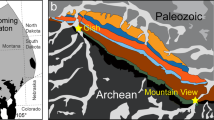Abstract
Pearce element ratios can test whether the members of a rock suite are comagmatic and can illustrate the causes of chemical diversity in comagmatic suites. Comagmatic rocks have constant ratios for elements conserved in the system during changes that led to the chemical diversity. In basaltic systems, the incompatible elements, Ti, K, and P, are often conserved. The slope of the trend on a Pearce element ratio diagram is sensitive to the stoichiometry of the crystallizing and segregating phases. A judicious choice of ratios as axes for the diagram provides a signature for the phases involved and estimates of their compositions. In basaltic rocks, diagrams with Ti/K vs P/K can provide a test of the comagmatic hypothesis. Diagrams with 0.5 [Mg + Fe]/K vs Si/K have trends that are distinct for each comagmatic suite and different mineral assemblage. Different suites are distinguished by the intercepts in diagrams, whereas mineral assemblages are recognized by the slopes of the trends. For example, if olivine is the sole crystallizing and segregating phase, the trend will have a slope of 1. Diagrams with [2Ca + Na]/K vs Al/K distinguish plagioclase from augite assemblages and, in conjunction with 0.5 [Mg + Fe]/K diagrams, unravel the crystallization sequences of suites that have suffered three phase crystallization and segregation. Analyses from the Uwekahuna laccolith, Kilauea, the 1955 and 1967–68 eruptions of Kilauea, Diamond Craters Volcanic Field, Oregon, and experimental data on MORB glasses provide illustrations of the interpretations that can be obtained from Pearce element ratios.
Similar content being viewed by others
References
Aitchison J (1981) A new approach to null correlations of proportions. J Math Geology 13:175–189
Aitchison J (1984) The statistical analysis of geochemical compositions. J Math Geology 16:532–564
Beswick AE (1982) Some geochemical aspects of alteration and genetic relations in komatiitic suites. In: Arndt NT, Nesbit EG (eds) Komatiites George Allen and Unwin, London pp 283–308
Chayes F (1964) Variance-covariance relations in some published Harker diagrams of volcanic suites. J Petrol 5:219–237
Chayes F (1971) Ratio Correlation: a Manual for Students of Petrology and Geochemistry. University Chicago Press, Chicago 99 p
Ghiorso MS, Carmichael ISE (1985) Chemical mass transfer in magmatic processes II. Applications in equilibrium crystallization, fractionation and assimilation. Contrib Mineral Petrol 90:121–141
Grove TL, Bryan WB (1983) Fractionation of pyroxene-phyric MORB at low pressure: an experimental study. Contrib Mineral Petrol 84:293–309
Ho RA, Garcia MO (1987) Origin of differentiated lavas at Kilauea Volcano, Hawaii: Implications from the 1955 eruption. Hawaii Symposium on How Volcanoes Work. Hawaiian Volcano Observatory Abstracts V:111
Jackson DB, Swanson DA, Koyanagi RY, Wright TL (1975) The August and October 1968 east rift eruptions of Kilauea Volcano, Hawaii. US Geol Surv Prof Pap 890:1–33
Kilinc A, Carmichael ISE, Rivers ML, Sack RO (1983) The ferricferrous ratio of natural silicate liquids equilibrated in air. Contrib Mineral Petrol 83:136–140
Murata KJ, Richter DH (1961) Magmatic differentiation in the Uwekahuna laccolith, Kilauea caldera, Hawaii. J Petrol 2:424–437
Nicholls J, Russell JK, Stout MZ (1986) Testing magmatic hypotheses with thermodynamic modeling. In: Scarfe CM (ed) Short Course in Silicate Melts. Mineralogical Assoc Canada 12:210–235
Nicholls J (1988) The statistics of Pearce element diagrams and the Chayes closure problem. Contrib Mineral Petrol 98:11–24
Nicholls J, Stout MZ (1988) Picritic melts in Kilaueaevidence from 1967–1968 Halemaumau and Hiiaka eruptions. J Petrology, in press
Pearce TH (1968) A contribution to the theory of variation diagrams. Contrib Mineral Petrol 19:142–157
Pearce TH (1970) Chemical variations in the Palisades Sill. J Petrol 11:15–32
Powers HA (1955) Composition and origin of basaltic magma of the Hawaiian Islands. Geochim Cosmochim Acta 7:77–107
Russell JK, Nicholls J (1985) Application of Duhem's Theorem to the estimation of extensive and intensive properties of basaltic magmas. Canadian Mineral 23:479–488
Russell JK (1986) A FORTRAN77 computer program for the least squares analysis of chemical data in Pearce variation diagrams. Computers and Geosc 12:327–338
Russell JK, Nicholls J (1987) Early crystallization history of alkali olivine basalts, Diamond Craters, Oregon. Geochim et Cosmochim Acta 51:143–154
Skala W (1979) Some effects of the constant-sum problem in geochemistry. Chemical Geology 27:1–9
Syme EC, Forester RW (1977) Petrogenesis of the boundary intrusions in the Flin Flon area of Saskatchewan and Manitoba. Canadian J Earth Sci 14:444–455
Tilley CE (1960) Differentiation of Hawaiian basalts: some variants in lava suites of dated Kilauean eruptions. J Petrol 1:47–55
Wright TL, Fiske RS (1971) Origin of differentiated and hybrid lavas of Kilauea Volcano, Hawaii. J Petrol 12:1–65
Wright TL, Swanson DA, Duffield WA (1975) Chemical compositions of Kilauea east-rift lava 1968–1971. J Petrol 16:110–133
York D (1966) Least squares fitting of a straight line. Canadian J Physics 44:1079–1086
Author information
Authors and Affiliations
Rights and permissions
About this article
Cite this article
Russell, J.K., Nicholls, J. Analysis of petrologic hypotheses with Pearce element ratios. Contr. Mineral. and Petrol. 99, 25–35 (1988). https://doi.org/10.1007/BF00399362
Received:
Accepted:
Issue Date:
DOI: https://doi.org/10.1007/BF00399362




